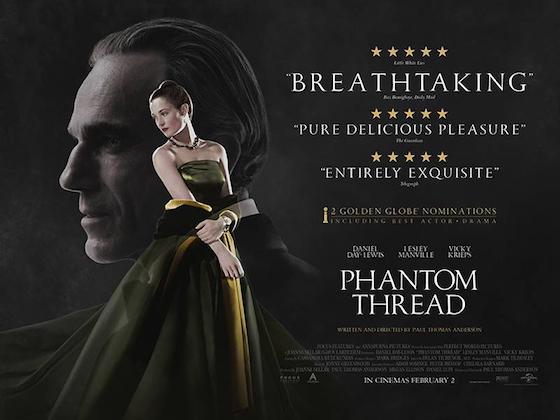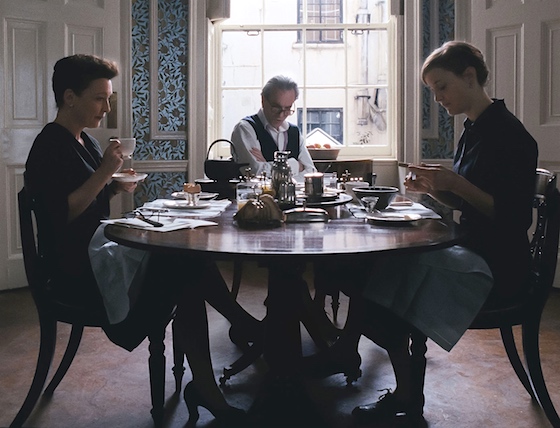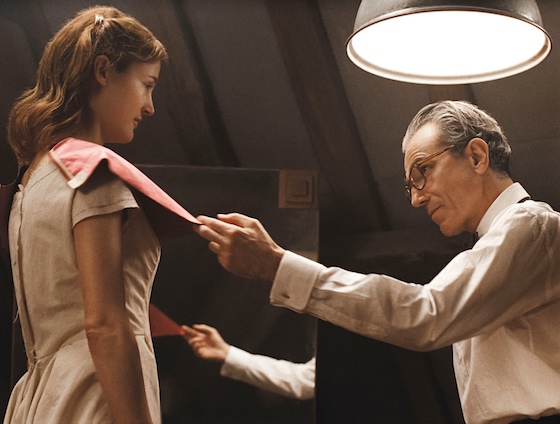Paul Thomas Anderson | 130 mins | 1.85:1 | download (UHD) | USA & UK / English & French | 15 / R

Reynolds Woodcock (Daniel Day-Lewis) is perhaps the most sought-after fashion designer in 1950s London, with a clientele that includes heiresses, countesses, and even princesses. But like many (male) geniuses, he is often prickly, exacting, tempestuous, and cold, and seemingly the only person that can withstand him for any length of time is his equally fastidious business manager — and sister — Cyril (Lesley Manville). Then Reynolds encounters guesthouse waitress Alma (Vicky Krieps) and is immediately smitten, a feeling which she reciprocates, and so she is quickly integrated into his life as his newest live-in muse/lover. Although she initially seems quiet and shy, Alma is actually headstrong and tenacious, and soon the three are locked in a love/hate battle of personalities.
If that sounds melodramatic, there is an element of that to the film; and if Reynolds and Cyril’s brother/sister relationship sounds a bit odd and Gothic, well, there’s an element of that too — and that’s without even mentioning Reynolds’ obsession with his dead mother, or what goes on with some mushrooms. But if there’s one thing writer-director Paul Thomas Anderson’s film is not, it’s histrionic. Its plot may be that of a Gothic melodrama, and if it were a novel perhaps we’d class it as one, but Anderson hasn’t taken on the skin of a Tim Burton or Guillermo del Toro here — in the quiet but forceful and precise way it plays out, Phantom Thread is as stringently produced as one of Reynolds’ gowns.

Similarly, at first glance the film may look as cold as its protagonist can be, taking place in the stark, plain-coloured corridors and rooms of his London home-cum-business, with central characters who seem pragmatic and aloof. It is primarily the arrival of Alma that reveals the truth, however, and while there are sometimes outbursts of emotion, a lot remains restrained, conveyed in glances or calmly-delivered threats. Although Day-Lewis received much of the attention and praise because, well, it’s Daniel Day-Lewis, this film truly derives its power from all three leads. It’s possible to point to scenes or moments where each shine, but the real effectiveness lies in how their characters are built up across the film.
Naturally, some credit for this lies with Anderson’s screenplay (which he reportedly wrote in collaboration with Day-Lewis, saying “he probably should have some kind of co-writing credit.”) There are many fantastic lines and dialogue exchanges — again, this might look like a staid, arty movie from the outside, but it’s alive and vibrant with wit and emotion, even if the former is all delivered very dryly and the latter is often simmering under the surface.
Anderson also deserves much credit for the look of the film. There’s no credited director of photography, because he didn’t hire one, but also because he didn’t claim to fulfil that role himself — according to IMDb, he stated that “he collaborated with and was advised by his camera operators and gaffers, since he does not have the technical expertise of a cinematographer.” The teamwork clearly paid off, because the photography is stunning. Not in a show-off, prettied-up kind of way (though there are still individual shots that are breathtaking, like this one), but just beautiful, crisp photography, which once again reminds us of the magnificence of shooting on 35mm (aided, no doubt, by the fact I watched it in UHD).

All of that remains in service of the characters and their story. I’ve seen it said the film is a dual character study, and I think that’s true. Reynolds and Alma are two very particular individuals, the truth of whose characters is brought out in the way they eventually spark off each other. Their relationship and where it leads is certainly not typical, and may not be healthy, either — indeed, I think how you ultimately react to it may say as much about you and your attitude to relationships as it does the characters. I’ve certainly seen a spread of interpretations expressed online, and (without meaning to sound like I’m above it all) I can understand most of the different perspectives. Of course, being of two minds is a reaction in itself.
I’m more certain of my reaction to the film itself. Put simply, it’s the Paul Thomas Anderson film I’ve felt most engaged by since I saw my first, Magnolia, 15 or so years ago (a feeling which didn’t endure to a rewatch some years later, incidentally). Maybe I owe the rest of his filmography a second chance.

Phantom Thread is available on Sky Cinema from today.
It placed 7th on my list of The 26 Best Films I Saw For the First Time in 2018.

 Mia Wasikowska stars opposite a British thesp best known for playing a comic book villain and a red-headed repeat-Oscar-nominee, in a Gothic drama-thriller from an acclaimed non-Anglo director? That’s a description of
Mia Wasikowska stars opposite a British thesp best known for playing a comic book villain and a red-headed repeat-Oscar-nominee, in a Gothic drama-thriller from an acclaimed non-Anglo director? That’s a description of  The story actually concerns Edith Cushing (Wasikowska), a well-to-do businessman’s daughter in upstate New York who is occasionally haunted by ghosts. She falls for visiting English gent Sir Thomas Sharpe (Hiddleston) and, long story short, moves with him and his haughty sister Lucille (Chastain) back to their crumbling — literally — pile in the English countryside. The house hides many secrets, and ghosts, too. Having said it’s not a horror movie, it would be unfair to class Crimson Peak as simply a tame drama — as you’d expect from writer-director Guillermo del Toro, those ghosts can be bleedin’ scary, and there are certainly a smattering of good old fashioned jumps to boot.
The story actually concerns Edith Cushing (Wasikowska), a well-to-do businessman’s daughter in upstate New York who is occasionally haunted by ghosts. She falls for visiting English gent Sir Thomas Sharpe (Hiddleston) and, long story short, moves with him and his haughty sister Lucille (Chastain) back to their crumbling — literally — pile in the English countryside. The house hides many secrets, and ghosts, too. Having said it’s not a horror movie, it would be unfair to class Crimson Peak as simply a tame drama — as you’d expect from writer-director Guillermo del Toro, those ghosts can be bleedin’ scary, and there are certainly a smattering of good old fashioned jumps to boot. Whatever one’s thoughts on the story and tone of the film, it can’t be denied that its technical merits are extraordinary. Every inch of the design work is gloriously imagined, and the cinematography — the lighting in particular — is spectacular. And that gigantic house set…! And the climactic ‘limbo’ set, too — incredible work. (That’s not a spoiler, incidentally: it was the set’s nickname, not its literal location.) The ghost effects are excellent too — original, creepy, and executed in a way that blurs the lines between make-up, animatronics, and CGI. It’s a shame the film as a whole wasn’t better received, because I imagine that’s all that held it back from numerous awards-season nods.
Whatever one’s thoughts on the story and tone of the film, it can’t be denied that its technical merits are extraordinary. Every inch of the design work is gloriously imagined, and the cinematography — the lighting in particular — is spectacular. And that gigantic house set…! And the climactic ‘limbo’ set, too — incredible work. (That’s not a spoiler, incidentally: it was the set’s nickname, not its literal location.) The ghost effects are excellent too — original, creepy, and executed in a way that blurs the lines between make-up, animatronics, and CGI. It’s a shame the film as a whole wasn’t better received, because I imagine that’s all that held it back from numerous awards-season nods.
 If The Locket is known for anything, it’s for a plot structure that places flashbacks within flashbacks within flashbacks. There’s always the potential for good fun in that kind of structure, though it’s usually the kind of thing that sounds more complicated than it is — the straightforward ‘concentric circle’ arrangement here makes them a doddle to follow; so straightforward, in fact, that it would be easy to miss how it was so structured.
If The Locket is known for anything, it’s for a plot structure that places flashbacks within flashbacks within flashbacks. There’s always the potential for good fun in that kind of structure, though it’s usually the kind of thing that sounds more complicated than it is — the straightforward ‘concentric circle’ arrangement here makes them a doddle to follow; so straightforward, in fact, that it would be easy to miss how it was so structured. It might have been more interesting if the doctor had been making it all up; or if it had been left open ended, with Nancy set to ruin someone else’s life. That could well have worked, leaving the audience to come to its own conclusions, etc. Considering the film’s age, however, I’m sure there were demands we see this thief and murderess brought to justice.
It might have been more interesting if the doctor had been making it all up; or if it had been left open ended, with Nancy set to ruin someone else’s life. That could well have worked, leaving the audience to come to its own conclusions, etc. Considering the film’s age, however, I’m sure there were demands we see this thief and murderess brought to justice. manipulative criminal it seemed all along, but instead a damaged individual doing these things involuntarily. This isn’t the wholly nonsensical part of the film — her apparently-accidental marriage to the son of the house she grew up in would be that bit — but I preferred it when she was just a villain. Psychologically it holds relevance, but at the same time she’s rather taken it to extremes. Or maybe I was just fed up by then.
manipulative criminal it seemed all along, but instead a damaged individual doing these things involuntarily. This isn’t the wholly nonsensical part of the film — her apparently-accidental marriage to the son of the house she grew up in would be that bit — but I preferred it when she was just a villain. Psychologically it holds relevance, but at the same time she’s rather taken it to extremes. Or maybe I was just fed up by then.